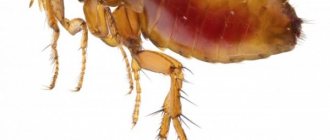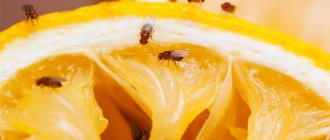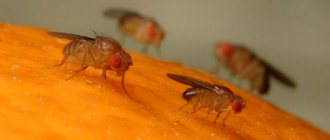If your poultry is constantly itching and forcefully plucking its feathers, it may have parasites - feather eaters. These are tiny insects that are invisible to the human eye, but cause great discomfort and harm to the bird - they can lead to a decrease in its egg production, loss of body weight and even death. We will find out further how to detect these parasites and remove them.
What kind of parasites are these?
The periodontal beetle, also known as the "chicken louse" or "chicken mite", is a small parasite that can be recognized by the following characteristics:
- body dimensions do not exceed 2-3 mm;
- the head is triangular in shape and protrudes above the body;
- the oral organs are presented in the form of a gnawing apparatus;
- body shape is flat and slightly elongated;
- the hard shell that covers the body is light brown with a hint of yellow;
- the body is divided into several segments, between which stripes of a dark shade can be seen;
- wings are missing.
Such parasitic organisms settle on the body of birds and live in their feather cover, holding on to it with the help of a jaw and three pairs of paws. Because of them, chickens become irritable because they feel severe itching. To cope with it, they begin to itch, pull out feathers and peck at each other.
This leads to loss of plumage in chickens, increased irritability and the appearance of small abrasions on the skin, which makes the environment more favorable for the development of parasites. In veterinary medicine, such a disease is called mallophagosis, so pereaters are also known as mallophages (down-eaters).
It should be noted that, unlike blood-sucking parasites, such parasites do not feed on the blood of chickens. The diet of pereaters includes:
- fluff;
- feathers;
- particles of dead skin;
- ichor, which is released from places of pecking and scratching of the skin.
The fertility of these parasites is quite high: at a temperature of 25-30°C and a humidity of 70-80%, one female a day can lay up to 10 eggs, attaching them to the feathers or down of chickens. The development cycle from egg to adult takes about 3-4 weeks.
The larvae usually emerge from the eggs 6-18 days after they are laid. Then they go through 3 stages of molting, each of which takes 12-18 days. After this, the parasites become adults, whose lifespan in the external environment is 6 days, and on the host’s body - 30 days.
One chicken is home to up to 10,000 parasites, which can migrate into bird bedding, equipment or flooring. It is believed that one sick chicken can infect the entire chicken coop with mallophagosis within a week. Young animals are most susceptible to the effects of pereaters.
Causes of chicken infection
As a rule, chickens develop feather eaters due to their close quarters in the chicken coop or non-compliance with veterinary hygiene standards. Initially, “mites” can settle in dirty equipment or a perch, and only after that - in the plumage of chickens.
Parasites can be carried indoors by the dirt-stained shoes of the worker who cares for the livestock. In addition, visiting the chicken coop area of wild birds - pigeons, sparrows, crows - increases the likelihood of infection with parasites. As carriers of bird eaters, they often fly into poultry feeders and come into contact with them. As a result, the parasites “move in” and infect chickens with mallophagosis.
A healthy bird can pick up “chicken lice” while taking baths with sick birds.
Poultry infection routes
There are several known routes of infection:
- From an already sick chicken while taking a dust bath.
- From wild birds flying into the yard.
- The insect can be brought by the owner himself on his clothes or shoes from another pen where infected chickens lived.
Distribution of the down-eater
Knowing in advance about the specifics of the spread of the feather eater, you can prevent mass disease in chickens. This insect is distinguished by its increased fertility; in less than a month, the female can lay a huge number of eggs.
Beetles choose warm and humid places for breeding. Females place their eggs at the base of the feathers or down; they are difficult to remove due to the dense adhesive base covering the egg.
From the laid eggs a larva emerges, which after three molts becomes a sexually mature individual. To do this, the pest needs to stay on the feathers for no more than three days.
Outside the body, the insect cannot exist for more than 4 days, so the feather eater spends almost the entire time of its existence on the body of the chicken.
Be sure to read:
How to cure coccidiosis in broilers: symptoms, treatment and prevention
Statistically, roosters clean their feathers less, which is why they tend to have more insects. The spread of the lice beetle is facilitated by untimely cleaning of the chicken coop and dampness.
Symptoms of mallophagosis
The following signs indicate the appearance of feather eaters in chickens:
- the feather shafts are damaged at the base;
- there are bare areas on the body due to the fact that the chicken constantly itches and pulls out fluff;
- the bird is in a state of constant neurosis and seems restless;
- young animals lag behind in development and gain weight poorly;
- a liquid is released from the eyes of birds, which, when dried, forms a crust;
- the affected areas gradually lose feathers and become covered with small abrasions.
As a rule, breeders identify a parasitic infection by a “bald back”, but in some cases this sign indicates baldness of the bird due to poor housing and feeding. The fact is that a lack of vitamin D, dry air and cramped conditions or stale air and high humidity lead to the bird shedding its feathers. This also occurs during normal shedding, although not to the same extent as during the disease.
Thus, to accurately determine mallophagosis, one should take into account the presence of not only a “bald back”, but also other symptoms characteristic of this disease.
We recommend that breeders read the article about what other dangerous chicken diseases exist.
Symptoms of chicken disease
According to statistics, roosters clean their feathers less, so most often they have a larger number of insects. To prevent the disease from affecting all chickens, it is necessary to immediately respond to the slightest manifestation of symptoms:
- The chicken is not feeling well. After infection, she becomes lethargic and sleepy due to excessive attempts to rid herself of the itch.
- Deterioration of the condition of the feather cover of birds: feathers become dull and fall out. You can see micro holes at their base.
- Constant feather cleaning and fluff plucking. This condition indicates that the disease began not so long ago, and it is still possible to prevent the spread of the pest.
- Decreased appetite and, accordingly, weight.
- Obvious bald spots.
- Eye discharge that turns into a crust when it dries.
- Wounds at the sites of bald spots.
- A sharp decrease in egg laying.
How to recognize mallophagosis
The disease can only be recognized after a thorough examination of the chicken.
The first step is to pay attention to the bird's behavior.
The first step is to pay attention to the bird's behavior. If she is excited or restless, it is better to inspect the entire body and feather covering
If she is excited or restless, it is better to inspect the entire body and feather covering.
Diagnostics
For experienced breeders, determining the disease is not difficult. New farmers should seek the help of professionals. They will be able to accurately tell what is bothering the chickens and determine the extent of the infection.
How dangerous are pereaters?
If treatment is not timely, you will have to face the following consequences of mallophagosis:
- a decrease in the productivity of laying hens by more than 10% as a result of weakening of their body;
- slow weight gain in chickens and broilers;
- the onset of sexual maturity of chickens later than expected;
- infection of birds with infectious diseases due to the appearance of open areas on the skin, which become covered with small wounds and become foci of penetration of skin infections;
- death of poultry;
- infection of the entire flock with a parasitic infection (parasites need the constant presence of the host, so they crawl from sick chickens to the feathers of healthy individuals).
For ornamental chickens, the presence of feather eaters is also unpleasant from an aesthetic point of view, since they disrupt the beauty of the plumage and lead to baldness of individual parts of the body. Feathers affected by parasites gradually fade and lose their shine.
How to withdraw?
If feather eaters have infected chickens, the breeder needs to perform two tasks - cure the infected individuals and prevent the spread of the parasitic infection. Meanwhile, removing this parasite will require quite a lot of time - on average 3-4 months, and in severe cases even six months. The fact is that after a one-time treatment of chickens, periodontal beetles may appear again, so several treatments will be required to completely destroy them.
The larger the distribution area, the more difficult it is to get rid of “chicken lice,” so you should not delay removing them.
To quickly and effectively destroy bird eaters, veterinarians recommend using a combination of synthetic drugs and folk remedies. If chemicals allow you to destroy lice, then home methods will repel them and serve as an excellent prevention of infection.
Folk remedies
To effectively combat beetles, the use of chemicals alone is not enough. To achieve better results, you should use home remedies along with them. It should be noted that these methods predominate in the treatment of young animals, since insecticides are too toxic for fragile organisms.
So, to cure hens and chicks from mallophagosis, you can use gentle folk remedies. These include:
- Chamomile infusion . To prepare a strong chamomile infusion, you need to pour 4 tbsp. l. dried flowers 1 liter of water and boil for 5 minutes over low heat. The infusion should be cooled, and then used to rub into the feather cover of adult hens and chicks.
- Dry wormwood powder . Powder made from dry branches and leaves of wormwood is also an excellent repellent. To enhance its effect, you can add pyrethrum powder (a type of chamomile) to it.
- Herbs . Beetles do not like the smell of a number of plants - chamomile, juniper, wild rosemary, wormwood, rosemary and tansy. So, in order to scare away parasites and force them to leave their “favorite” room, dried grass should be scattered over the litter, interspersed with straw or hay. In addition, the infusion of these herbs can be sprayed on an infected bird using a spray bottle. It can also be rubbed into chicken feathers.
- Sand-ash baths . To clean a bird's feathers of parasites, it should be bathed in saws. This method is especially effective in small areas of infection. So that chickens can take such baths, it is worth placing special boxes in the chicken coop or aviary (depending on the time of year), which are filled in equal parts with wood ash and clean sand. To enhance the therapeutic effect of this mixture, you can add a powdered insecticide to it.
At the slightest discomfort, chickens will “bathe” in these baths. In this case, the sand-ash mixture will envelop the plumage, which will cause the bird eaters to suffocate, and the down and feather cover of the bird will be cleaned and deprived of excess moisture.
Kerosene has also proven itself to be effective in the fight against chicken lice. It is believed that it has a detrimental effect not only on beetles, but also on their eggs, which compares favorably with chemicals. However, kerosene has an aggressive effect and is therefore contraindicated for chickens. Thus, products based on it are suitable only for adult chickens. Here is one effective recipe:
- Mix kerosene with water and 9% vinegar in a ratio of 1:2:1/4 so as not to burn the sensitive skin of the bird.
- Shake the resulting mixture first, and then use it to treat the feather cover.
Kerosene can also be mixed in equal parts with ammonia and benzene. This solution is suitable for treating not only birds, but the entire chicken coop.
Chemicals
Birds affected by the lice beetle will need to be separated from healthy individuals in order to prevent the development of the epidemic. Next, sick chickens must be treated with special insecticides, which are sold in veterinary pharmacies. These include:
- Frontline;
- Leopard;
- Beafar;
- Unoiled;
- Stronghold;
- Celandine.
These products are intended for removing lice and ticks from domestic animals (cats and dogs), but they are also successfully used in the treatment of mallophagosis in chickens. They should be purchased in the form of sprays for treating chicken feathers. Drops are recommended for isolated cases of infection.
If there are a lot of sick birds, veterinarians recommend using other forms of antiparasitic agents, which should be given special attention:
- Butox . Refers to universal antiparasitic agents. Available in liquid form, diluted with water and used to treat chicken feathers using a spray bottle. The product can also be used to disinfect the chicken coop.
- Insectal . The drug is available in powder form and is intended for application to the chicken’s body. They need to powder the bird, lightly rubbing it into the base of the feathers.
- Arpalit . It is an aerosol that has the safest composition for birds, so it can even be used to treat young animals over 2 months old. Arpalit should be sprayed evenly over the chicken's plumage.
- Nyuda . This is a spray for human lice, but can also be used to kill beetles. The cost of the drug is quite high, but it has low toxicity, so it is excellent for treating rare breeds or a small number of infected birds.
Regardless of the drug chosen, the following rules should be observed when processing poultry:
- Apply drops to the feather cover in the back area. It is advisable not to skip a single area, treating not only the infected areas, but also the entire feather of the bird, so that the parasites do not have the opportunity to crawl onto untreated areas and develop further.
- Apply the spray evenly over the entire feather cover, paying special attention to areas under the wings and bald areas. In this case, it is extremely important to spray the drug from a distance of 15-20 cm from the feathers. To prevent it from getting into the chicken's eyes, the head should be covered with a cloth. In any case, we must remember that insecticides in spray form cannot be used to treat chickens under 3 months of age.
- The drug in powder form must also be rubbed evenly into the feather of the bird, treating both affected and healthy areas.
- As soon as the insecticide is applied to the feathers, the bird's beak should be tied for a while so that it cannot peck itself at the treatment site. Adult parasites and larvae die within a few minutes, depending on the effectiveness of the drug used.
- All individuals should be treated - both sick and healthy. In the future, this will prevent cross-infection and the spread of parasites.
Toxic compounds cause paralysis in adult feather eaters, but have virtually no effect on the egg. In this regard, the treatment should be repeated after 7-10 days to destroy newly hatched parasites. If this is not done, then after 14 days the chicken will again be infected with lice.
Some breeders in the summer recommend carrying out a second treatment 9 days after the first, and in winter - 12 days later. In any case, the interval between treatments must not be neglected, otherwise the birds may suffer and even die.
The exact procedure for processing chicken is determined by the instructions indicated on the packaging of each drug. If you ignore these rules, irreparable harm can be caused to birds.
Fighting methods
Feeding in chickens is a case where it is easier to prevent than to get rid of. Sometimes the struggle lasts a whole year. Currently, the parasite can be eliminated using chemical and folk methods. And the best thing is to combine them.
Interesting video:
Chemicals
Both the chickens themselves and the room in which they live are treated. This is done simultaneously. The entire bird must be processed. Both sick individuals and healthy ones. Since it is impossible to determine the presence or absence of a parasite by eye at the initial stage of the disease. Preparations for treating chickens are sold at a veterinary pharmacy. All those that are used to combat fleas, ticks in animals and lice in humans are suitable.
- Drops Frontline;
- Spray Bprs;
- Stronghold;
- Unsmeared;
- Insectol;
- Celandine;
- Arpalit;
- No lice.
Drops are applied to the feathers in the back area. You should keep the bird's beak closed or tie it for some time. The spray is applied from a distance of 15-20 cm to the entire feather cover. The insect suffers paralysis, followed by sudden death. In this case, the adult and larvae die. The feather eaters will be safe in the egg, so after 7-10 days it is necessary to re-treat the chickens. Before this date, the procedure is prohibited. Because the bird itself may suffer. There is nothing complicated about disinfecting chickens. However, there are some disadvantages. For example, when treating a bird with a spray, the feather eaters can move to the neck. And other areas of the body that could not be treated well. Do not use on chickens. Therefore, in parallel with chemical professional preparations, folk remedies for parasites are used.
Folk recipes
- Sand-ash baths - troughs with such a mixture should always be present in the chicken coop. Birds must have constant access to it. The insect will die or flee from constant such baths. And for the chickens it will be a real pleasure. Preparing this product is very simple - sift fine sand and mix with wood ash.
- Kerosene - mixed with water or vinegar. Can also be used in its pure form. They simply lubricate the bird and leave it to work. The insect dies from lack of oxygen. Since the oily composition of kerosene penetrates the respiratory tract, the chitinous cover. This procedure is acceptable for adult chickens. Chickens are treated a little differently.
- Chamomile infusion - rub well into feathers and skin. The procedure is repeated every day. You can also use dry chamomile and wormwood powder.
Disinfection of the chicken coop
Bird eaters settle not only in the feathers of birds, but also in bedding, garden tools and even the wooden structures of the premises itself. So, to get rid of parasites, it is not enough to treat the chickens - at the same time, you will need to disinfect the chicken coop.
For these purposes, medications are used against fleas, cockroaches, ants or bedbugs. The selection of the composition depends on the degree of infection of the room - if there is an abundance of parasites, products with a high degree of toxicity should be used. The most popular insecticides for indoor treatment are:
- Karbofos (aqueous solution 0.5%);
- Pyrethrum (aqueous suspension 10%);
- Butox (diluted 1 ml per 4 liters of water).
You should refrain from using drugs like Dichlorvos, since their vapors are excessively toxic and can cause harm to the health of birds.
After choosing the optimal product, you can begin treating the room in accordance with the following instructions:
- Temporarily relocate the livestock to another place of residence.
- Wear tight overalls, a respirator, clear plastic goggles and rubber gloves.
- Prepare a solution, observing the correct dosages, since most drugs show maximum effectiveness in the environment only at the optimal concentration. So, on the packaging you should find the appropriate dosage of the drug for disinfecting the room.
- Remove food, bowls and feeders from the chicken coop, and also throw away all wooden products that could become shelters for “mites”. Be sure to take out the litter, which is better to burn or take to a landfill.
- Clear the room of chicken droppings, feed residues and straw.
- Treat the perches, walls and floor of the chicken coop with the prepared solution. To treat a room, it is better to use an emulsion-based solution, since the consumption of an aerosol or spray will be too large, so several bottles will be required, which will significantly increase the cost of fighting lice.
- Close the doors of the room and wait a while for the vapor to be absorbed into all the cracks. Afterwards the room can be ventilated.
- Lay the floor with new bedding and return clean equipment.
Birds can be returned to the chicken coop 2 days after it has been treated with a disinfectant.
Preventive measures
To significantly reduce the risk of chickens becoming infected with peri-eaters, you should follow simple preventive measures:
- Minimize the use of wood in the chicken coop, since this material is a favorable environment for the life of lice eaters.
- Maintain an optimal balance of humidity in the chicken coop and keep it clean - change the litter as it gets dirty, and also treat the floor and walls, feeders, nests and perches with boiling water.
- Do not keep birds in cramped enclosed spaces and provide them with the opportunity to walk.
- Monitor the chickens' diet, giving them the necessary minerals, vitamins, proteins and fats.
- If possible, avoid contact of chickens with wild birds - tits, pigeons, sparrows, etc., since they can be carriers of feather eaters.
- Carefully inspect the chickens in order to promptly identify the slightest signs of infection and prevent the spread of harmful insects.
- Observe hygiene rules. It is advisable to prepare special clothes and shoes for working in the chicken coop, so as not to bring in parasite eggs from the street.
Compliance with a set of preventive measures will protect poultry from becoming infected with periodontal beetles.
Video: how to kill feather eaters in chickens?
During the cold season, chickens are often kept in close quarters, as a result of which they become infected with periodontal beetles. You can get rid of them with the help of a special drug - Delcid. How to treat infected chickens with this composition is described and shown in the following video:
If chickens begin to act nervously, pluck their feathers and, as a result, go bald, they may be infested with feather eaters. These parasites can reduce the chicken's productivity and even lead to its death. In this regard, it is extremely important to do everything necessary to destroy them, and in the future follow preventive measures to prevent re-infection of the bird.
0
0
Copy link
Symptoms of appearance
The presence of a parasite can be determined by the way a bird behaves. The appearance of periodontal beetles will certainly make itself felt with a number of signs that have clear differences from other diseases:
- the bird is constantly itching and trying to pull out feathers;
- Baldness is observed in places, and holes form where feathers have fallen out;
- the plumage has damage at the base;
- the birds are very nervous, constantly cleaning their plumage;
- the growth of young individuals slows down, adult chickens slowly gain weight as they lose their appetite;
- the chickens stop laying eggs.
We recommend reading: Marmoset pygmy monkey. Description, features, species, lifestyle and habitat of the marmoset. The article will tell you in detail about the marmoset, its characteristics and types.
If you do not pay attention to the abnormal behavior of birds for a long time, this can lead to a decrease in their productivity. In addition, laying hens, when pecking at the skin, form wounds that fester over time.
Pus and inflammation in wounds are very dangerous. If there is no treatment and delay in getting rid of parasites, this can lead to the death of the laying hen.











